Home University of Edinburgh Library Essentials
July 26, 2024
AI vs the Imago Dei : views from US theological libraries

Computer17293866, CC BY-SA 4.0 , via Wikimedia Commons
On Tuesday 18 June, I flew half way around the world to attend the Atla conference in Long Beach, California. There were two questions that Atla delegates asked me that I had to pause and think about to answer. The first was ‘Why did you come such a long way to attend this conference?’ (the second was ‘Are you the library director? – well … no.). To answer the first, I was able to attend the Atla 2024 conference due to a generous travel grant from Atla itself, support from BETH (European Theological Libraries) and support from ABTAPL UK & Ireland. I was attending as a UK representative of BETH, but I also wanted to attend because of the unique theological library context, and because attending an international conference is a great learning experience. As at professional development events in the UK, AI dominated the agenda – here are some conference highlights.
Grand debut into Heritage: A Peek into my Collections Care Assistant Role
Isabela Tapia Hernandez
The Collections Care Assistant role was created for our students to explore the cultural heritage sector through employment and support their career aspirations post-graduation.
This is the second of three blog posts detailing their time with us!
Reflections on a Journey in Conservation: My Time as a Collections Care Assistant
Back in March we welcomed our new Student Collections Care Assistants; Abigail Miskin, Ella Joyce and Isabela Tapia Hernandez. Four months on and it is time to say goodbye and thank you to the first, Abigail, who has been offered an amazing opportunity to shadow a team of conservators in Italy, learning Paintings Conservation and develop on the skills she has learned here with us.
The Collections Care Assistant role was created for our students to explore the cultural heritage sector through employment and support their career aspirations post-graduation. This inaugural year involved collaborative efforts to optimise the role for students, collections, and service. Abigail, Ella and Isabela exhibited exceptional communication, maturity, flexibility, and a willingness to learn, making the role’s first year highly successful. These qualities also allowed the established team members to learn and improve the role, which we aim to continue offering in 2024-25 and beyond.
This is the first of three blog posts detailing their time with us!
It’s audit time!
Anyone who has attended a meeting, had a conversation in the corridor, or bumped into me in one of our stores, knows that one of my main talking points for at least the past 5 years has been my ambition to undertake a campus-wide audit of the Art Collection. Obviously, there have been a few major world events that have hindered this, but it’s finally happening!
With over 8000 works in the collection, and at least 31% of them on display around campus (1845 works over 415 separate locations!), it’s not a straightforward job. We will have to gain access to office spaces, lecture halls, corridors, and seminar rooms, as well as taking a deep dive into the artworks held in storage.
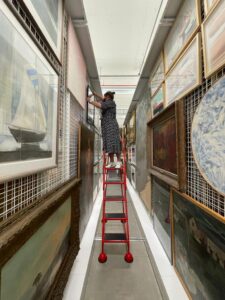
Anna checking artworks in store
As usual, we rely on a spreadsheet to keep us in check. Although the most important detail is updating the location, we are also looking at the condition of the artworks, whether they need to be photographed, and what fixings are installed on the back. All of this will make it easier for us to provide access (online, for exhibition, teaching, or loan) or identify artworks that need further work to make them available. This information will be uploaded to our Collections Management Database (Vernon CMS) to enable greater location control and improve overall information on each of the artworks.
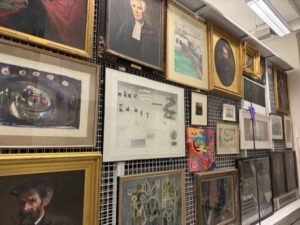
Artworks in store
The audit has begun in earnest, with 2313 works in storage listed and locations updated as of the beginning of this month. Alongside this work, our Documentation Assistant Gaby is also running trials on the use of barcodes on artworks for location control, which I’m sure you’ll be able to read about in a future blog post! We’ll be out and about on campus for the next year, so please say hello if you spot us.
Anna Hawkins
Museum Collections Manager
Edinburgh Open Research Conference 2024
This is a guest blog post from Emma Wilson, Emma is a final year PhD student in the Centre for Clinical Brain Sciences. She is currently interning with the Library Open Research Team.
On 29th May 2024, we held the third annual Edinburgh Open Research Conference online and in person at the John McIntyre Conference Centre. Over 300 people attended the hybrid event, from Edinburgh and further afield, to listen to a jam-packed programme of talks and posters on all things open research.
This year’s theme was culture change, and thinking about how open research principles can steer us towards healthy and inclusive research environments.
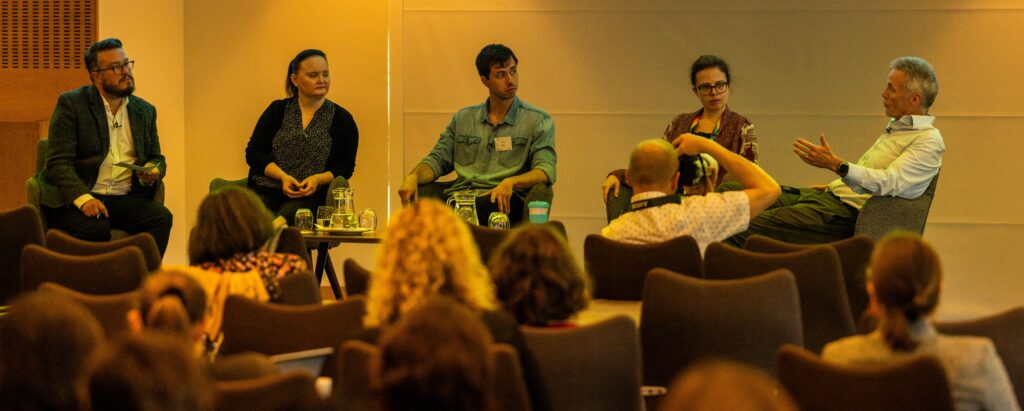
Plenary panel – photo credit: Eugen Stoica
The events kicked off with a plenary panel featuring Nick Wise (University of Cambridge), Rowena Lamb, Malcolm Macleod, and Katie Nicoll Baines (all University of Edinburgh) discussing the ways in which we can drive healthy and sustainable culture change and how this applies in the context of open research.

Marisa de Andrade delivering her keynote – photo credit: Eugen Stoica
Presentations and lightning talks touched on the topics of education and skills, research culture change, and next generation metrics. We heard from a diverse range of perspectives including technicians, researchers in both STEM and the humanities, and professional services staff. Equality, diversity, and inclusion (EDI) was a strong theme running throughout each of the presentations.
The keynote lecture was delivered by Marisa de Andrade on ‘The Madness of Metrics and Possibilities of Pause in Open Research’, which offered perspective on research metrics, what they really mean, and what really matters.
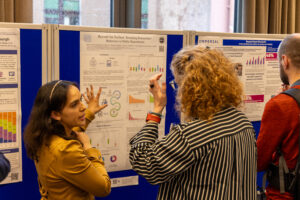
Poster session – Photo credit: Eugen Stoica
Following a busy day, the conference closed with a drinks reception and posters. Each presenter gave a quick-fire summary of their poster in a round of ‘Minute Madness’.
We want to thank everyone who attended the conference, our fantastic presenters, and of course our organisers Kerry Miller and Nel Coleman for making the day enjoyable and insightful. And if you missed it, be sure to come along next year!
Stay up to date on open research activities and future conference announcements by signing up to the Edinburgh Open Research Newsletter and joining our Edinburgh Open Research Initiative Microsoft Teams group.
Knowledge Exchange Week 2024 – Reflections
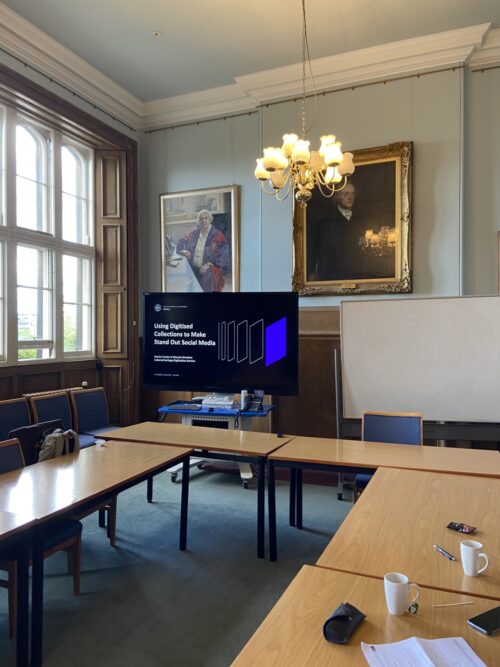
Last month, team members Marian and Miranda attended Knowledge Exchange Week, hosted by the University of Edinburgh. This was the fifth time the event had been held, and the theme was the ‘Open Library.’ The event also incorporated the Edinburgh Open Research Conference. After a whirlwind week of programming and networking, we thought it might be interesting to hear more about what they learned and experienced.
Commissioning data handling modules for MANTRA
We are seeking to commission new software-specific data handling modules in the Research Data MANTRA training resource (https://mantra.ed.ac.uk/), as the ones there have become outdated (https://mantra.ed.ac.uk/softwarepracticals.html). The online modules have been refreshed more regularly by the Research Data Support team. There will be a short turnaround for the commissioned works, which will be incorporated into MANTRA and the Research Data Service.
There is £2,000 available per module for new modules to be authored by end of July, 2024.
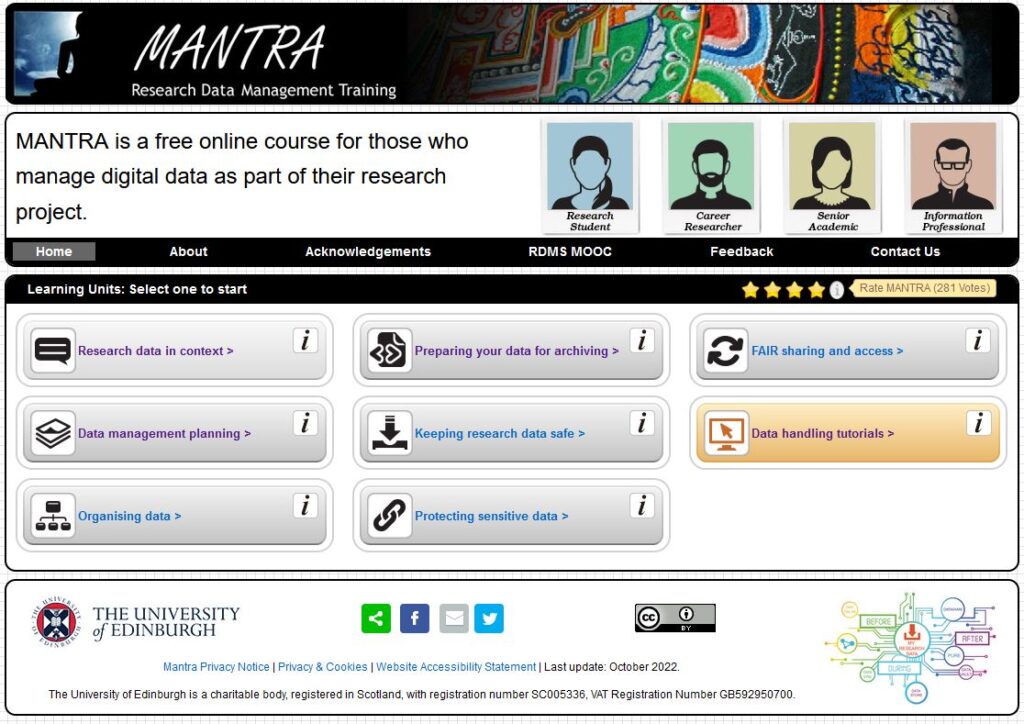
What are the software modules in DataShare?
As an extension to the overall MANTRA resource which covers good practice in research data management, each software module contains a one to one a half hour practical to work through which will teach skills needed to handle data properly within the software environment. It is not intended to be an introduction to the software, and a certain level of proficiency with the software may be assumed (any prerequisite knowledge should be stated).
Each module contains:
- a PDF document stepping through the practical so the learner can work at their own pace;
- and a publicly available dataset that can be used within the practical, such as a UK government dataset or an open access dataset from a repository. The dataset can be based in any discipline but should not require discipline-specific skills to understand and use.
Currently, we have a module for SPSS, R, ArcGIS and Nvivo.
How do I submit my proposal to author a software module?
We are interested in proposals for authoring accessible data handling tutorials in specific modern software environments, including potentially SPSS, R, Python, QGIS, and Nvivo.
To be considered for this commissioned work, please send a one to two page outline of what the practical will entail in a PDF document to R.Rice@ed.ac.uk by end of Friday 28th June, 2024. Interested parties are welcome to get in touch before the outline is complete, stating their intention. The outline must include the author’s name, email address, and postal address, with or without telephone number. The outline may also contain:
- prerequisite knowledge that the learner is assumed to have in order to complete the module successfully, such as familiarity with a particular type of software or experience of coding;
- specific learning objectives of what the learner will gain by working their way through the module;
- headings indicating sections of the tutorial;
- descriptions of what will be covered beneath each heading and what the learner is expected to do, using the software of interest;
- a citation of the dataset to be used with the practical, including the name and location.
The commissioning process
The Research Data Support team will evaluate the proposals and select the authors to proceed with the commissioned works. Notification will be by email. Authors will be expected to comply with the University of Edinburgh’s terms and conditions for suppliers, which includes transfer of any IPR to the University. Upon evaluating the material, we may choose to make edits for purposes of clarity or accessibility. Current members of staff of the University may need to receive payment through their associated unit (to be determined).
All materials for the full software modules must be passed to the University by Friday 26th July. Progress before that date will be assessed through email correspondence. An invoice for work completed must be submitted after the team confirms the content is complete and to specification before 31 July in order to be paid in full.
Robin Rice
Data Librarian and Head of Research Data Support
Library and University Collections
5 things: using the Library over the summer
It’s officially the summer vacation period at the University and our libraries remain open for business. So whether you are planning on using Library resources, facilities or services during this time or if you will be away from Edinburgh for the summer and want to forget about University as much as possible, here are five important things to remember about the Library over the summer period.
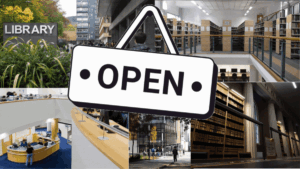
1) The Main Library and all 9 site libraries remain open throughout the summer vacation period.
Opening hours and staffed hours will be reduced in many libraries so check the opening hours website before you visit and follow the Library on social media for any updates – Instagram, Twitter/X, Facebook.
The Main Library will continue to be open 24/7 throughout the summer but EdHelp staffed hours will be slightly reduced between Friday 7 June and Friday 6 September 2024. Read More
RESP Outreach Intern – End of Internship
Written by: James Rice, RESP Outreach Intern
With the launch event completed, my internship was coming toward its end. After six months, I was surprised at how quickly it had gone by. But for now, I turned my attention to catching up on my remaining responsibilities.
My first week after the event was spent completing the writeups of the blog posts that have already been published on our site, as well as having a go at creating an updated banner for the page. Additionally, I put together and sent out a follow-up email to our event launch, notifying guests that Rebekah’s online exhibition had now been published. Alongside this, with a form put together by Rebekah, I also gave a link asking guests where possible for feedback on the event itself.
After this, I directed my focus to writing out a report reflecting on my experiences with the RESP. In doing so, I was able to also prepare a short presentation for an ‘Allstaff’ meeting where I described my achievements with heritage collections staff at the University of Edinburgh. I was so glad that I had put together a journal entry of my weekly tasks with the RESP, as that made putting together a script for this meeting, as well as the report and these blogs, so much easier!
With these responsibilities out of the way, and my final tutorial video iteration edited and completed, my time with the RESP as an intern was completed.
My internship with the RESP at the CRC over the last six months has been an incredibly rewarding experience. Applying for this role with the intention to gain practical experience working with a collection and learning more about the day-to-day operations within the Heritage Sector, I can confidently say that I achieved these goals. Additionally, I am proud of what I was able to accomplish over this period and how much I developed professionally while balancing my time with my postgraduate education.
Building on my experience already from various voluntary roles across London and Edinburgh, I have no doubt that this internship has made me a valuable candidate for roles in the future once I complete my masters. This role has given me the chance to build my competence across outreach, event management, and working closely with an archive to develop promotional materials to support the launch of an online exhibition.
While I initially felt overwhelmed with the possible routes that I could potentially take with my internship, pitching my ideas to an experienced team in January allowed me to solidify the objectives that I hoped to achieve through my work.
Throughout, I felt welcomed and supported by staff. In particular, I felt confident to ask questions to my supervisors Lesley Bryson and Caroline Milligan at the RESP, and engagement officer Bianca Packham whenever needed; with their feedback and guidance always being appreciated and contributed to a strong sense of learning and personal growth in the field.
Overall, this internship has been a significant step in my professional journey. It has reinforced my passion for working in the heritage sector and given me a clearer vision for the career path I wish to pursue going forward. I feel confident that I have been equipped with the necessary skills to succeed and thrive in this field.
I am incredibly grateful for this opportunity with the RESP. The lessons I can take away from this experience will undoubtedly benefit me as I move forward. I want to thank Lesley, Caroline, and the CRC for this opportunity, and my fellow intern Rebekah for our work together!
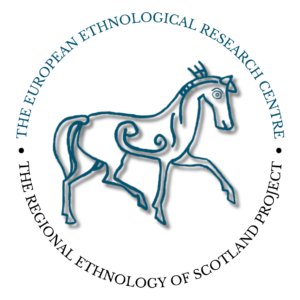
Collections
 Archival Provenance Project: Emily’s finds
My name is Emily, and I’m the second of the two archive interns that...
Archival Provenance Project: Emily’s finds
My name is Emily, and I’m the second of the two archive interns that...
 Archival Provenance Project: a glimpse into the university’s history through some of its oldest manuscripts
My name is Madeleine Reynolds, a fourth year PhD candidate in History of Art....
Archival Provenance Project: a glimpse into the university’s history through some of its oldest manuscripts
My name is Madeleine Reynolds, a fourth year PhD candidate in History of Art....
Projects
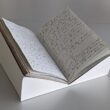 Sustainable Exhibition Making: Recyclable Book Cradles
In this post, our Technician, Robyn Rogers, discusses the recyclable book cradles she has developed...
Sustainable Exhibition Making: Recyclable Book Cradles
In this post, our Technician, Robyn Rogers, discusses the recyclable book cradles she has developed...
 Giving Decorated Paper a Home … Rehousing Books and Paper Bindings
In the first post of this two part series, our Collection Care Technician, Robyn Rogers,...
Giving Decorated Paper a Home … Rehousing Books and Paper Bindings
In the first post of this two part series, our Collection Care Technician, Robyn Rogers,...

